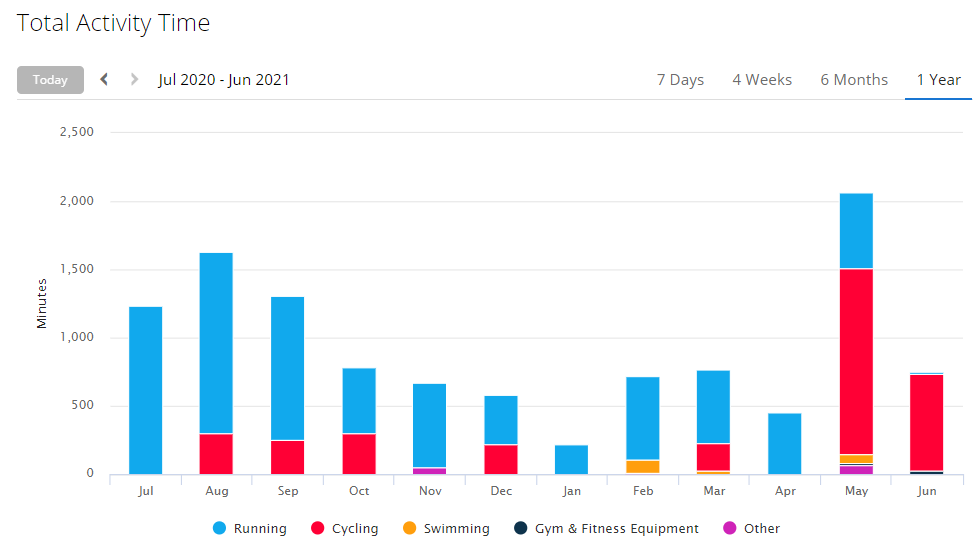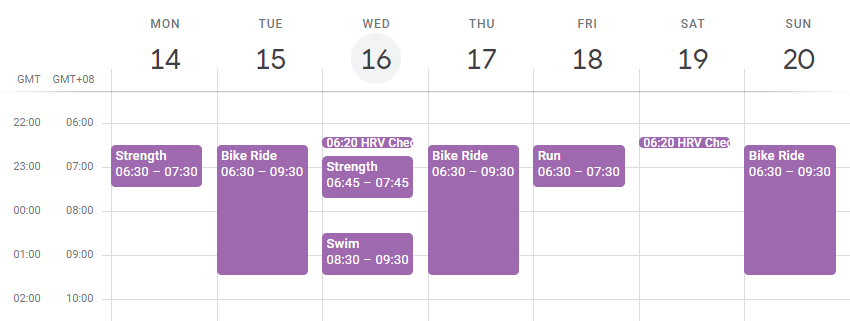For a long time now my fitness program has been at full-throttle or no-throttle, with very little in-between. I could keep up a good average of running 3-6 times/week for several months, but inevitably I’d then have several weeks (or a month) of barely any training, putting a big dent in any fitness gains I’d made.
I’m once again closer to full throttle than off, and this post is to add additional accountability and motivation to keep the throttle on, as well putting my plan down in writing. Another reason for the post is that I’ve recently become an official member of the Axle Sports sim racing team, and as part of the driver contract they have a clause stipulating a minimum fitness training requirement – got to keep the training going!
The past:
I’ve run a few marathons, half-marathons, and 10k races. For a few of them my training was pretty good, and for others it was far from adequate. My gym-work has been much less frequent compared to my cardio.
In 2020 I averaged about 35km of running each week, and a small amount of cycling/gym/swimming on top of that. In 2019 the average was only about 12km/week, so the trend is upwards!
I often get motivated to train hard for various reasons, but then that motivation would wane, and I’d find excuses to skip a week, or two, and the downward spiral begins.
I draw motivation from a lot of factors, such as:
- I feel I should be fit enough that I don’t look/sound like a hypocrite when I tell drivers I coach that they should focus on their fitness levels.
- Improved health – much benefits, many wow.
- Faster when I hop in a kart (keeping weight down), and faster/more consistent in all racing because of improved focus from better fitness levels.
- Beating personal bests in running/cycling.
- Better sleep. Moving more helps me sleep better… and sleeping better makes me feel better, which means I move more. It’s a glorious positive cycle.
My past 12 months in minutes/month of training:
The graph above from my garmin connect account gives a glimpse into my inconsistency. A few very quiet months in there, for no real reason other than being lazy. The last time I missed an entire month without going for a run/ride was March of 2019 – not quite as bad as I thought, but there has been a fair few very quiet months over the years in addition to that completely zero month.
The Present & Future:

As can be seen in the graph above, I’m currently in an on-throttle phase of fitness in May and June. I aim to keep it that way! To maintain it in a sustainable way requires some planning in the form of creating habits, avoiding injury, settings goals, and having the structure in place to schedule the time required.
I’ve recently started replacing a lot of my running with road cycling in addition to the occasional mountain bike ride. A friend has been super generous and given me his road bike to get a hang of things, and I’ve really enjoyed it. It’s a nice change from running with its own set of challenges and aspects to enjoy. It has a few more similarities to car racing as well with some braking, cornering, and vision skills involved.
Creating Habits:
“Motivation gets you started, habits keep you going,” a quote from Jim Ryun – the first high school runner to run a mile under 4 minutes. It’s quite easy for most to get motivated to workout for a day, a week, or even a month or two, but beyond that motivation is rarely enough. Life-long fitness is best created through habits.
I’ve read/and or listened to a few books on habits. The power of habit by Charles Duhigg is an enjoyable read. Atomic Habits by James Clear is similar and has a bit more actionable advice.
The Atomic Habits method of creating habits is summarized with the below points:
- Make it obvious.
- Be specific with what it is that you will do. “I will go for a run at 7:20am every weekday” instead of “I will exercise more often”
- Tie-it to an existing activity/habit. “After I brush my teeth, I’ll put on my running gear.”
- Make it attractive.
- Make the habit engage your dopamine (feel-good) response. While I enjoy running/exercise to a certain extent, I’ve made it even more attractive by tying my habit of listening to podcasts/books to it. I now enjoy running/working out more, and am more likely to do it because I get to listen to a good book or podcast while doing it.
- Make it easy.
- Reduce the friction to get started as much as possible. Put your running gear next to your bed the night before, and make a rule to simply head out of the door (easy) rather than to run 10km (not always easy).
- Make it satisfying. “What is immediately rewarded is repeated. What is immediately punished is avoided.”
- I reward myself after a bike ride or run by relaxing in the swimming pool immediately after. I always have that to look forward to even when it gets tough. If there’s no pool, it’s relaxing with a nice glass of sparkling water while browsing my Strava achievements.
There’s more to it than that of course, but that’s the crux of it. “You do not rise to the level of your goals, you fall to the level of your systems.”
Avoiding Injury:
Avoiding injury is obviously important. I’m writing this while dealing with some annoying tendinitis behind my knee that has disrupted my sleep and effectively forced me to stop running. My friend loaning me his amazing Giant Propel bicycle came at a great time because cycling is considerably easier on the joints, and the bicycle allows me to take longer breaks from running without dropping my fitness levels.
I do want to get my running mileage back up to the 25km/week range or more, but I won’t rush it. To really let my leg heal, I’ll initially try about 4 weeks without a single run.
The same goes for other possible injuries or over-training. If something’s not right, I slow it down or replace it with something that doesn’t strain the injury. Slow it down rather than stop completely is key to keep the habit going. Keeping a habit going by going for a walk instead of a hard exercise will do it.
Goals & Tracking Progress:
My primary measure of success is simply getting off my ass and out the door. If I consistently get out of the house 5 times a week do something, that’s level 1 of success. Even if it’s just a 10 minute walk around the block, it counts (and keeps the habit going). The more serious goal is 5 cardio sessions each week, and 2 strength training sessions/week.
In the past I haven’t recorded my strength training on my fitness watch (currently a Garmin 645 Music), but have now started to do so in order to have a more complete picture of my progress.
I will track a few more metrics. Weight is simple – I weigh myself most days, and I’m currently at 77kg, and aim to get that down to about 75kg. I’ll be satisfied keeping that anywhere in the 72 to 76kg range. Less weight = more climbing personal bests on the bicycle, and faster running with less impact on my joints!
I’ll also start tracking my Heartrate Variability (HRV) using the Elite HRV app (available for Android and iOS). I’ve heard HRV mentioned often recently in fitness and even racing podcasts.
The basics of heartrate variability is that instead of your heart beats per minute, it tracks the variation in time between each heart beat. More variability is good – the theory being that it enables the heart to respond quickly to different situations. I’ll have to read up more on it to understand the details.
More structure:
As with creating habits, hitting my goals will likely be helped with more structure to my program.
I want to be flexible with my structure as well – if I suddenly get some work which throws my Sunday morning ride out the window, I’ll slot in an effort the day before, the evening of, or another time I can find. If I don’t wake up as early as planned, it’s going to be a hotter bike/run later in the day (or cooler evening)… if I can’t get it done that day, I do it the next day.
I have set myself a few minimums, including specific (but not rigid) timing for them:
- 3 Bike rides/week
- 2 Strength training sessions (typically less than an hour)
- 1 Run/Week (replaced with a walk or other activity when recovering or avoiding injury)
- 1 Swim/Week
The runs/swims/rides have no minimum distance goals, but I do have some goals that I strive towards such as the aforementioned climbing goal.
Ending Notes
I wrote this article largely for myself as a form of additional accountability, but if you’ve come all this way, thanks! I’ll post an update during the first week of every coming month, and maybe some other random updates along the way – to keep the accountability going.
External links to Further Reading/Things Mentioned:


